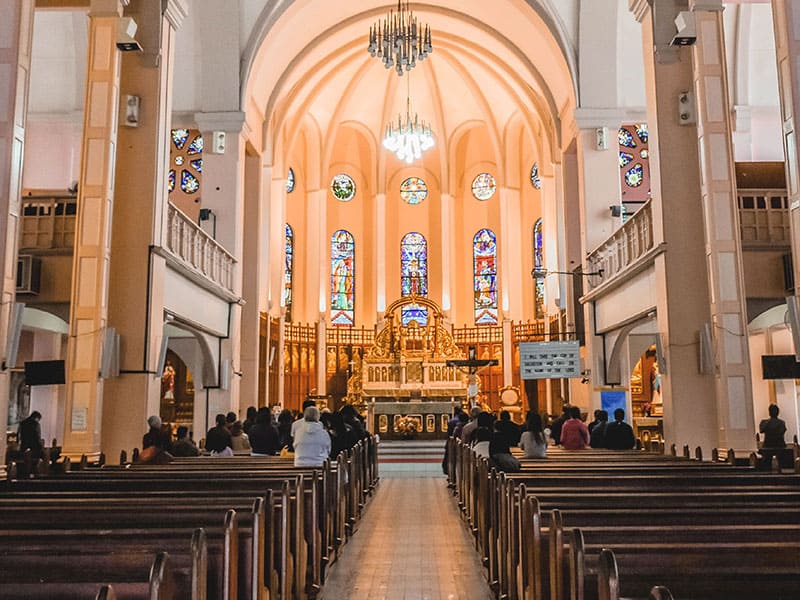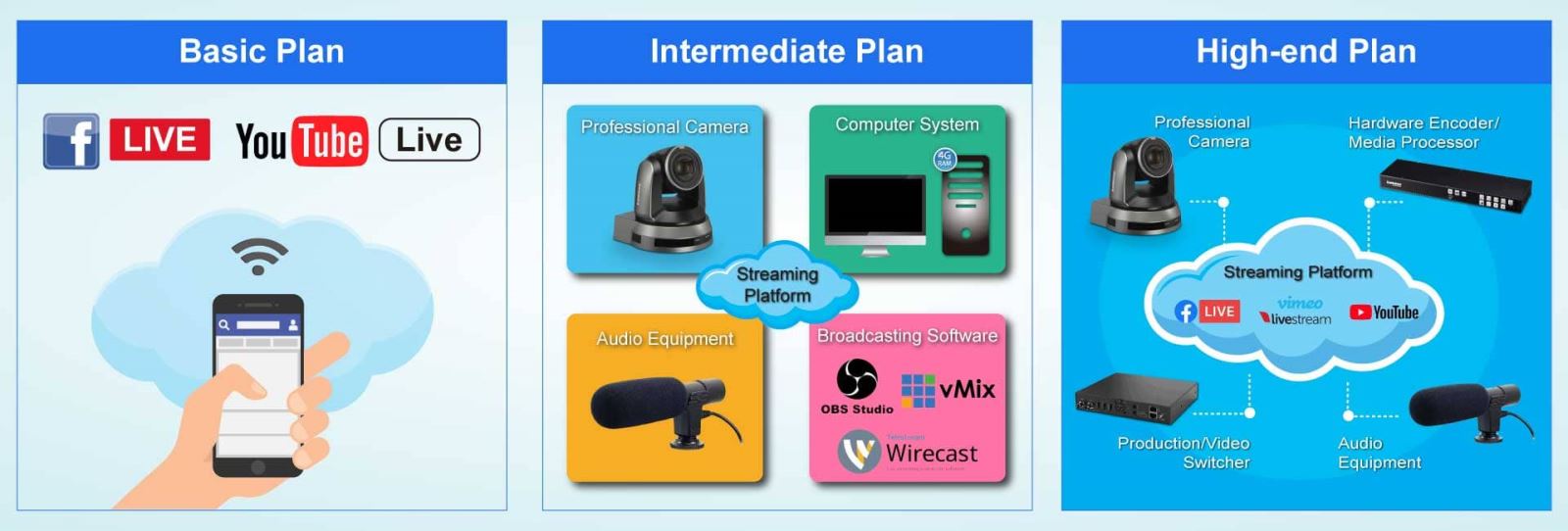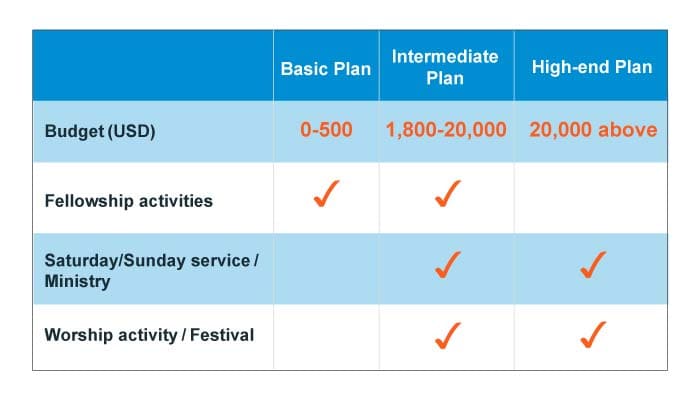【ProAV Lab】How to Choose Streaming for a House of Worship
By Lumens Editor Group
January 21, 2020 24552

Introduction:
Houses of worship worldwide are incorporating live streaming as a way to extend their reach among worshippers as well as people who do not attend services. There are many options for adding streaming to HOW live broadcasts. We can roughly divide these options into three types according to the price of the plan: the Basic plan, the Intermediate-level plan and the High-level plan.
1 Basic Plan (Budget: 0-500 USD)
1.1 This low-cost plan can be achieved simply through the use of a mobile phone and a live broadcast platform. The live broadcast platform can use APPs such as YouTube and Facebook with almost no cost.
1.2 Although inexpensive, most houses of worship will not opt for this method because of quality issues. Although today’s smartphones have good cameras, they still cannot achieve high-quality broadcast video, and the very limited production capabilities of phones will result in a boring video that will not easily attract viewers. Audio quality will also be a serious issue because of the phones’ single, small microphone.
1.2 Although inexpensive, most houses of worship will not opt for this method because of quality issues. Although today’s smartphones have good cameras, they still cannot achieve high-quality broadcast video, and the very limited production capabilities of phones will result in a boring video that will not easily attract viewers. Audio quality will also be a serious issue because of the phones’ single, small microphone.
2 Intermediate Plan (Budget: 1,800- 20,000 USD)
2.1 The intermediate plan is also known as a software solution and carries a moderate cost. The required equipment includes professional cameras, wireless and/or wired microphones, computer systems, and live broadcaster software. The minimum equipment required for this solution is:
2.1.1 Professional camera: This can be a PTZ camera or a shoulder-mounted video (broadcast) camera.
2.1.2 A computer system: a fast processor such as an Intel i5 dual-core and at least 4G RAM will provide the best results (slower computers will result in choppy video). The operational software loaded onto the computer (see below) will manage the stream to the live broadcast platform.
2.1.3 Microphones and mixing equipment: In addition to using the built-in microphone of some cameras, directional microphones will help to achieve better audio. Microphones are usually placed at the pulpit, over the choir, and in musical performance areas. Wireless microphones are commonly used due to their convenience and the ability to allow free movement. Whether wired or wireless microphones are used, a small mixing console can help users manage various audio sources. This mixer can also handle line-level inputs from computers, DVD players, and so on.
2.1.4 Live broadcasting software: This is software that simplifies the process of video mixing and switching, gives users some special effects capabilities, and prepares the broadcast for live streaming. OBS is one of the most common tools, and it's free. Paid software options are also available such as vMix, Wirecast, and Livestream, which can provide users with more powerful functions.
2.1.3 Microphones and mixing equipment: In addition to using the built-in microphone of some cameras, directional microphones will help to achieve better audio. Microphones are usually placed at the pulpit, over the choir, and in musical performance areas. Wireless microphones are commonly used due to their convenience and the ability to allow free movement. Whether wired or wireless microphones are used, a small mixing console can help users manage various audio sources. This mixer can also handle line-level inputs from computers, DVD players, and so on.
2.1.4 Live broadcasting software: This is software that simplifies the process of video mixing and switching, gives users some special effects capabilities, and prepares the broadcast for live streaming. OBS is one of the most common tools, and it's free. Paid software options are also available such as vMix, Wirecast, and Livestream, which can provide users with more powerful functions.
2.2 The advantage of this solution is that the installation is simple, and is generally a “do-it-yourself” option. The cost is also acceptable. The price of the live broadcaster software is relatively cheaper than that of a full hardware solution. With the increased flexibility of the live broadcasting software and its customizable mixing/switching/effects capabilities, the audience will receive a more interesting stream.
2.3 The disadvantage of this solution is that because it is not a fully installed system, it will generally be put away after each use, and equipment may be re-purposed for other uses during the week. This will mean that users may need to reset the software before each use, locate the video and audio sources and confirm they are connected properly, and test whether the system is operational again. In addition, the stability of the software has a lot to do with the computer system. Software updates (which often happen at the most inconvenient times) and compatibility with computer systems are also a common problem encountered by users. In addition, usually the computer is not only used for a live broadcast, it will also be used for word processing, Internet access, post-production of videos, etc. This will cause great challenges to the software management of live broadcast guides and computer stability, including hard disk capacity and CPU usage.

3 High-end plan (Budget: above 20,000 USD)
3.1 The high-level solution is also known as a hardware solution. It is a relatively high-cost solution and is also the best choice for faith-based organizations who wish to achieve professional-quality results. The equipment will include one or more professional cameras, (handheld, tripod mounted, PTZ and/or box cameras ); wired and/or wireless microphones, an audio mixing console, a production/video switcher, a hardware encoder/media processor and live streaming platform.
3.2 The benefits of this solution are high quality and ease of use. Each device is designed for a specific function, ensuring maximum quality and stability. These systems are usually permanently installed and are dedicated solely to the broadcast function, giving users a repeatable and automated process. These high-level systems are quickly available, customizable to the users’ precise needs, and are easy to use.
3.3 The disadvantage of this solution is that the price is not cheap. Installation, wiring and configuration should be completed by a professional system integrator. Compatibility between devices, wiring behind walls or in ceilings/floors, device mounting that will be both convenient and unobtrusive, are some of the concerns that will make it difficult for users to handle by themselves.
There are many system integrators who specialize in HOW installations. Professional A/V organizations such as NSCA (nsca.org) and AVIXA (avixa.org) can help you locate integrators in your area.
3.2 The benefits of this solution are high quality and ease of use. Each device is designed for a specific function, ensuring maximum quality and stability. These systems are usually permanently installed and are dedicated solely to the broadcast function, giving users a repeatable and automated process. These high-level systems are quickly available, customizable to the users’ precise needs, and are easy to use.
3.3 The disadvantage of this solution is that the price is not cheap. Installation, wiring and configuration should be completed by a professional system integrator. Compatibility between devices, wiring behind walls or in ceilings/floors, device mounting that will be both convenient and unobtrusive, are some of the concerns that will make it difficult for users to handle by themselves.
There are many system integrators who specialize in HOW installations. Professional A/V organizations such as NSCA (nsca.org) and AVIXA (avixa.org) can help you locate integrators in your area.
4 How to choose?
4.1 No one solution is perfect and no one solution is suitable for everyone. Use the following comparison table to choose the best solution for your house of worship.
Regardless of the initial plan, software plan, and hardware plan, each has its own advantages and disadvantages. Your faith-based organization can choose the most favorable live broadcast plan according to the budget and worship function requirements.
Tag:
Solution
